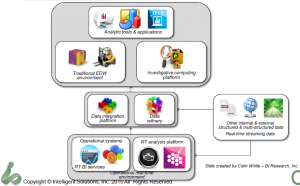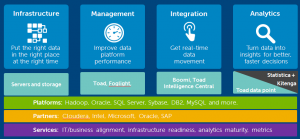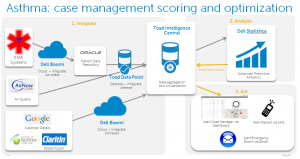The Internet of Things (IOT) is something more and more people are considering. Wednesday’s TDWI webinar topic was “Stream Processing: Streaming Data in Real Time, in Memory,” and the event was sponsored by both SAP and Intel. Nobody from Intel took part in the presentation. Given my other recent post about too many cooks, that’s probably a good thing, but there was never a clear reason expressed for Intel’s sponsorship.
Fern Halper began with overview of how TDWI is seeing data streaming progress. She briefly described streaming as dealing with data while still in motion, as opposed to data in warehouses and other static structures. Ms. Halper then proceeded to discuss the overlap between event processing, complex event processing and stream mining. The issue I had is that she should have spent a bit more time discussing those three terms, as they’re a bit fuzzy to many. Most importantly, what’s the difference between the first two?
The primary difference is that complex event processing is when data comes from multiple sources. Some of the same things are necessary as ETL. That’s why the in-memory message was important in the presentation. You have to quickly identify, select and merge data from multiple streams and in-memory is the way to most efficiently accomplish that.
Ms. Halper presented the survey results about the growth of streaming sources. As expected, it shows strong growth should continue. I was a bit amused that it asked about three categories: real-time event streams, IOT and machine data. While might make sense to ask the different terms, as people are using multiple words, they’re really the same thing. The IoT is about connecting things, which interprets as machines. In addition, the main complex events discussed were medical and oil industry monitoring, with data coming from machines.
Jaan Leemet, Sr. VP, Technology, at Tangoe then took over. Tangoe is an SAP customer providing software and services to improve their IT expense management. Part of that is the ability to track and control network usage of computers, phones and other devices, link that usage to carrier billing and provide better cost control.
A key component of their needs isn’t just that they need stream processing, but that they need stream processing that also works with other less dynamic data to provide a full solution. That’s why they picked SAP’s Even Stream Processor – not only for the independent functionality but because it also fits in with their SAP ecosystem.
One other decision factor is important to point out, given the message Hadoop and other no-SQL folks like to give. SAP’s solution works in a SQL-like language. SQL is what IT and business analysts know, the smart bet for rapid adoption is to understand that and do what SAP did. Understand the customer and sales becomes easier. That shouldn’t be a shock, but technologists are often too enamored of themselves to notice.
Neil McGovern, Sr. Director, Marketing, at SAP gave the expected pitch. It was smart of them to have Jaan Leemet go first and it would have been better if Mr. McGovern’s presentation was even shorter so there would have been more time for questions.
Because of the three presenters, there wasn’t time for many questions. One of the few question for the panel asked if there was such a thing as too much data. Neil McGovern and Jaan Leemet spent time talking about the technology of handling lots of streaming data, but only in generalities.
Fern Halper turned it around and talked about the business concept of too much data. What data needs to be seen at what timeframe? What’s real-time? Those have different answers depending on the business need. Even with the large volume of real-time data that can be streamed and accesses, we’re talking about clustered servers, often from a cloud partner, and there’s no need to spend more money on infrastructure than necessary.
I would have liked to have heard a far more in-depth discussion about how to look at a business and decide which information truly requires streaming analysis and which doesn’t. For instance, think about a manufacturing floor. You want to quickly analyze any data that might indicate failures that would shut down the process, but the volumes of information that allow analysis of potential process improvements don’t need to be analyzed in the stream. That can be done through analysis of a resultant data store. Yet all the information can be coming across the same IoT feed because it’s a complex process. Firms need to understand their information priority and not waste time and money analyzing information in a stream for no purpose other than you can.


